
By Howie, LunaCobra.net.
See more in “Hand Tattoos“ (Tattoos)
This cute little tattoo (no, it wasn’t done with the pen to the right of the little toe. Damn my suspicious mind) belongs to Nurse Kim, let’s hope her colleagues at work don’t take it literally!
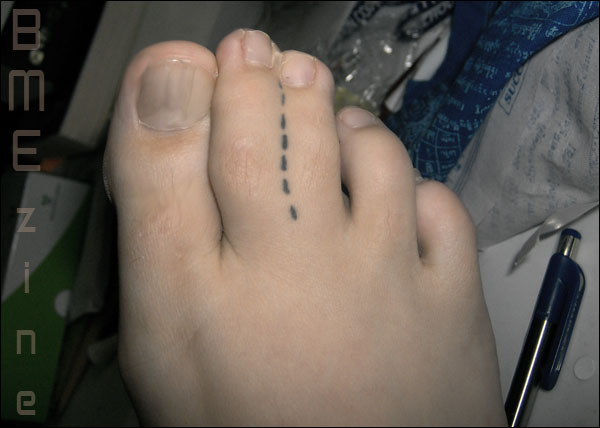
See more in “Hand Tattoos“ (Tattoos)
Says Matt (or Matty, or Matty Matty Water Ratty, apparently we can call him whatever we want).
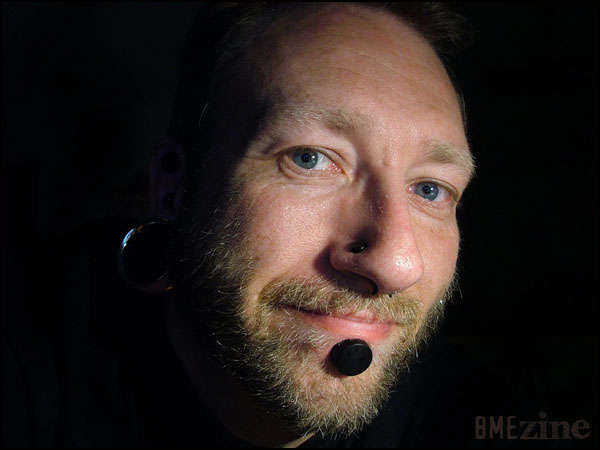
Well Betty, I love a good face and you’ve got just the type I like.
See more in “Scalpelled and other large gauge lip procedures“ (Lip Piercing)
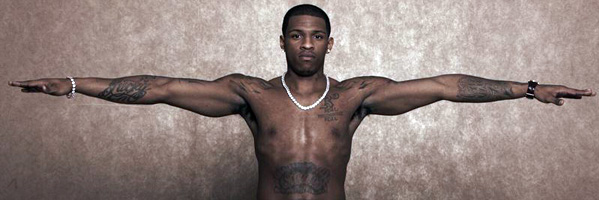 |
| Photo source: RashadMcCants1.com |
This video is from January, but it’s new to us! NBA players with tattoos are nothing new, but Rashad McCants is a bit different. For one, he’s an unabashed poet who publishes his pieces on his Web site, but beyond that, he takes his tattoos — and indeed, tattoos in general — very seriously. He writes about his at length:
My greatest analogy for tattoos is that life is pain. The new challenges you encounter in life present a type of pain that could make a person give up. The moment you feel the discomfort, you divert to what’s comfortable and less painful. But a tattoo makes it all mental. Separating the mind from body and focusing on the outcome of the challenge. The pain never lasts forever — it’s just temporary. In life, going through bad times also means good times are soon to follow. The moment you decide not to fight the bad times, everything turns around for you. And the outcome is more satisfying then ever.
That’s the same with a tattoo. It hurts like hell the moment that needle touches your skin. And it continues to hurt until its done. And even a couple days after. But, just as with life’s trials and tribulations, the pain subsides and the outcome is everlasting. There is nothing like a fresh tattoo. The look of it. The feel of it. Knowing that it hurt so bad, and you wanted to quit.
In the video, McCants is followed around during a photo shoot for Inked Magazine, and offers even more about what tattooing means to him:
Rashad McCants Shows Off His Tattoos [YouTube]
Tinted Tattoos [RashadMcCants1.com]
While it’s still absolutely a company’s prerogative whether it chooses to hire visibly modified folk, it’s becoming an increasingly poor business decision for a variety of reasons. Sure, there was a time when the conventional wisdom was that tattoos were strictly the domain of the lowest rungs on the ladder, but that’s a borderline indefensible position nowadays. Hell, when 24-percent of people in the coveted 18-50 age-range have at least one tattoo, it seems almost senseless. And apparently, human resource departments are catching on!
At some point, a blanket no-tattoos policy will almost certainly compromise your ability to hire the talent you need, and it would appear to move against a general trend to be more tolerant of tattoos. Educational level and social status no longer predict who has body art. The young financial officer who handles your business banking may have a Celtic symbol on her ankle. The lawyer who works your case may simply take out his nose ring when he goes to court.
As a result, many major employers have revised their tattoo policies, making them more lenient. Disney is good example. After polling the people who visit their theme parks and finding little objection, the company lifted tattoo restrictions. Faced with talent shortages, many hospitals have moved from a no tattoo policy, to a “no highly visible tattoos” stance.
This may seem like old news — indeed, it certainly is — but it’s undeniably positive and surprisingly progressive. Of course, the trend is not as far-reaching as some would hope:
That said, the professionals who responded to the SHRM survey made it clear that body art still leads to stereotyping. Furthermore, in a 2007 survey 85% of respondents said that tattoos and body piercings impede a person’s chances of finding a job.
 |
 |
Now, as someone who often laments the fact that he was born in an era in which wearing a three-piece suit at all times isn’t quite necessary, I personally love the cognitive dissonance of seeing an impeccably dressed person with hints of tattoos peeking out from behind cuffs and collars. There should be some sort of decorum when it comes to the way one dresses for work, but I don’t think a dress code and body modification are irreconcilable, either. My favorite take on this comes from Keith Alexander, who was, among many other things, a heavily tattooed ball-breaker that flourished in marketing and advertising:
[…] the older generations [are] dying off and the younger generations [are] coming up, and the majority of them have [tattoo] work. […] So, look, we’ve reached critical mass as far as public awareness goes: Everybody knows there’s people like us and people crazier than us doing these things. So, they’re aware of it, it’s just a matter of your resumé and experience being able to back it up. I don’t think that, given the choice between a person who is somewhat qualified and not pierced or tattooed and a person who is extremely qualified and pierced and tattooed, I think that the business environment is such these days that you have to make the right choice to go for the person that’s best for the job, visible work or not.
[…]
So it’s really … I hear so many people just whining about, “My quote-unquote mods keep me out of jobs,” and I really don’t buy into that. If you have a full facial tattoo and you got it when you were 16 and it’s shitty art, then maybe that is working against you, but I don’t have much sympathy for you. So again, I’ve never really had a problem, it’s always just a matter of setting the goal and going for it. I’ve counseled and helped so many of my friends with going through transitions like that because I’ve done it so many times, and the advice that I give them is to just pick what you want to do and go for it.
[…]
The best thing to do is just live your life and lead by example. You know, that’s what I like to do; I can’t tell you how many times I’ve been in big presentations, I’ve just given a great presentation, everyone’s just kind of blown away, and then I roll up my sleeves and people are like, “Holy shit, that’s a lot of work,” and you know, I’m totally aware of when I do it, how I do it, why I’m doing it, and so on. So you just have to set an example by the way you live your life.
Tattoo News [CollegeRecruiter.com]
RTFM: Keith Alexander [BMEzine.com]
Tesa (the guy with the mask over his mouth rather than his eyes) was kind enough to send in these photos of a tongue split he did on a client recently..
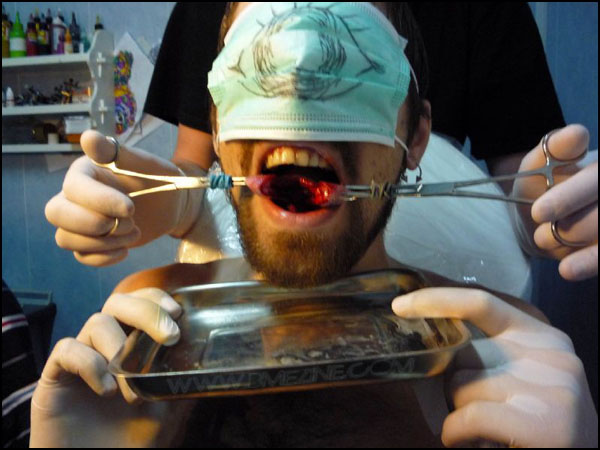
See more in “Tongue Splitting“ (Tongue Surgery) (members only)
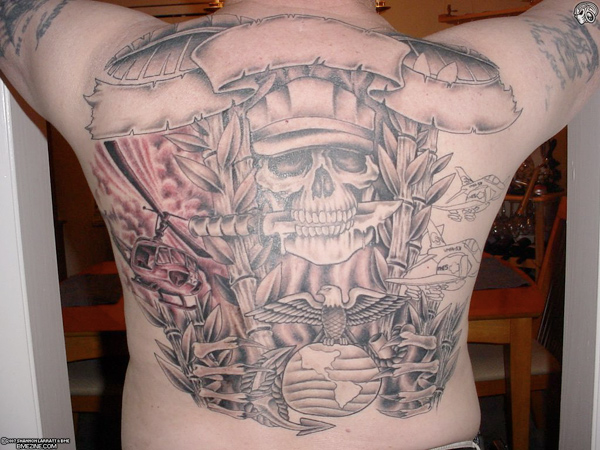
[Military.com] If the History Channel has taught me anything (aside from providing a God’s-eye view of everything that ever happened to Hitler), it’s that the military has a proud tradition of commemorative tattoos, with each branch rather attached to its own unique iconography. In March 2007, however, the Marine Corps cracked down on and banned full-sleeve tattoos for Marine recruiters or security guards, though those with work completed before a certain date were grandfathered in. Now, a new administrative decision has extended the ban even to those who were granted an allowance:
[The decision defines] sleeve tattoos as a large tattoo or collection of smaller tattoos that covers or almost covers a person’s arm or leg. This also includes half and quarter sleeves if they are visible in green-on-green, physical training gear. […]
“Sleeve tattoos degrade our professional Marine image,” said Staff Sgt. Aaron McMullen, canvassing recruiter, Recruiting Substation Clarksville, Ind., Recruiting Station Louisville, Ky. “We keep our uniforms pressed, our brass shiny and our shoes polished. Sleeve tattoos don’t fit with that image.”
Marines with tattoo sleeves who are already on recruiting will be allowed to finish their tours however, recruiters wishing to submit a career-recruiter package “may not be favorably viewed” but will be considered on a case-by-case basis. The decision will ultimately rest with the deputy commandant for manpower and reserve affairs.
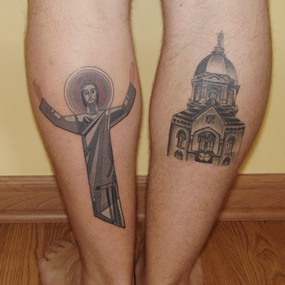 |
| Photo credit: ESPN.com |
It’s an unfortunate decision; one would hope their contributions would be highly valued enough that a tattoo sleeve wouldn’t have to inhibit Marines’ official interaction with the public. On the other hand, decorum seems vital to the USMC, and if they won’t truck with a moo-stache, maybe this shouldn’t be a complete surprise.
[ESPN.com] ESPN the Magazine recently put out a call for readers to send in photos of their College football-related tattoos, and at least 18 did! Nothing particularly striking, though I have to say, sports tattoos is one area in which BME is definitely lacking. I’m putting you on notice, sports fans! Start sending in photos of your tattoos. We know you’re out there.
[ThePittsburghChannel.com] Lindsay Lohan totes got tattoos to match Samantha Ronson’s! In more exciting news, the driver on the bus I take had his hair parted to the opposite side than usual this morning.
[Technoccult.com] OK, this is just plain awesome. I don’t know the context (or if the title, “Religious Body Piercing in India,” is in any way accurate), but this is the video to which they link — never mind the safety pins:
You probably remember this post from a few weeks ago. As promised, Emilio has sent in photos from about 10 days ago. I’m not sure how long after the procedure they’re from but we’ll keep you updated as the photos come in.
See more in “Facial restructuring“ (Facial Sculpting) (members only)
Though I think it’s usually dumb and misguided, I have a hard time taking issue with a company that institutes a dress code that prohibits visible, tasteful modifications — by all means, that sort of thing is up to the discretion of the owner. When it comes to a school board banning them, however? It often comes off as an arbitrary and thoughtless use of power. So it goes in Portales, New Mexico: 13-year-old Kierra Seales has been informed that the clear bead she wants to wear in her lip piercing is unacceptable, and that the piercing will have to come out while at school. Her mother, Nkoshe, is calling it a First Amendment issue:
 |
| Photo credit: PNT / Mickey Winfield |
“If we could accomplish changing the wording of the dress code, both sides would benefit,” Nkoshe Seales told the board. “The students would feel like they have the freedom to express themselves, and the administration and staff would no longer have to make an issue of the fashion trend.”
The current Portales schools’ dress code policy for piercing states that no student shall wear nose rings or nose studs or any type of visible body piercing accessory with the exception of earrings in the ear. […]
“The First Amendment is freedom of expression. Whether youth have First Amendment rights is still a legal question, but what is not in question is that they will (have them) some day,” Nkoshe argued. “Constraining them now from expressing themselves is no preparation for exercising those rights.”
Nkoshe has opened up a dialogue with the school board on the issue, and the board’s superintendent, Randy Fowler, seems open to reviewing the current rules and determining if a change in order. Nkoshe’s argument goes beyond a simple constitutional defense, though, and insists there are tangible benefits to body piercing:
“Piercing is a healthy and positive thing in some people’s lives,” Nkoshe said. “It encourages personal growth and self-discovery. Body piercing is the safest and most positive (expression) a youth could embrace given the alternatives of drugs, sex and gang violence.”
Well, I’m not sure those are the only alternatives, but … what do I know? Let’s see what the readers of the Portales News-Tribune have to say!
I wonder what this mother would think if Portales Schools went to using school uniforms? With the large number of students now, it would be helpful to the teachers if they knew who exactly should be on campus for safety reasons. Does she think teachers should also be able to express themselves by wearing what they would like and showing what they would like?
Hmm … well, the teacher issue seems like a bit of a straw man, but I’ll grant that if it’s a particularly problematic area, uniforms shouldn’t be discounted immediately. Even still though, aren’t piercings compatible with the institution of uniforms? One would think …
“I hope the School Board will remain firm in the set policy. Wearing a pistol on the hip, running naked in the streets are all part of self expression however thankfully there are laws and rules. Our schools are to teach. Teaching rules is part of education. This is why children are willful today.”
“Please change the rules for me because I am more special than all of the other kids who have gone through these schools and followed the rules. BULL!!!! I think it would be a very different circumstance if someone were to go into their place of business here in town and urinate in the floor. I think Ms. Seales would be very upset with you, and I don’t think she would be any happier if you told her that it was ok and should be allowed because you were just expressing yourself on the carpet.”
Oh, God damn it.
Mother protests school district policy on piercings [Portales News-Tribune]

(Editor’s note: This article was first published in The Point, the publication of the Association of Professional Piercers. Since part of BME’s mandate is to create as comprehensive and well rounded an archive of body modification as possible, we feel these are important additions.
Paul King, the article’s author, has given BME permission to publish a series of articles he wrote for The Point that explore the anthropological history behind many modern piercings. This is another in that series.)
In the piercing world we have come to call the piercing of the ear’s concha a “conch” piercing, pronouncing the ch softly, as in “church.” However, per Webster’s New World Dictionary, 2nd edition, the correct pronunciation of the ch should be hard, sounding like the letter “K.” I bring this up merely as a matter of curiosity or trivial fact; I am certainly not suggesting the piercing community should stray from tradition. Sometime in the early 1990s, the original Nomad body piercing shop in San Francisco, owned by Blake Perlingieri and Kristian White, started referring to this piercing as the “Sadhu,” a rather catchy name that has stuck to an extent, and which refers collectively to Indian Hindu holy men. “Incorrectly they are sometimes referred to as ‘Fakirs’ who were originally Moslem street magicians who adopted a few yogic techniques for their repertoires and used them solely for entertainment.”1 It is a particular subsect of these Sadhus, the Gorak Naths or Gorakhnathis, that have their conchae pierced.
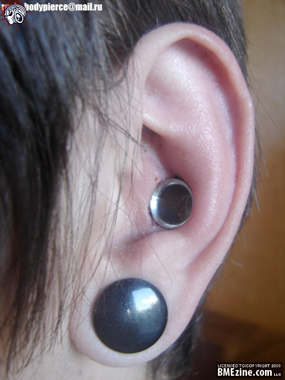 There is little historical documentation of the conch piercing, and its practice seems sporadic within different cultures. Other than the Gorak Naths, I have only found the Mangebetu to have strong cultural ties to the perforation and adorning of the Concha.
There is little historical documentation of the conch piercing, and its practice seems sporadic within different cultures. Other than the Gorak Naths, I have only found the Mangebetu to have strong cultural ties to the perforation and adorning of the Concha.
The Mangebetu, sometimes spelled Mangbetu, are an African tribe found in the Republic of Zaire (previously known as Congo). The Mangebetu were formerly regarded for their sophisticated court and developed arts; it is the women of this tribe that can still be seen wearing the beautiful long pieces of ivory in their conchae. The conch perforations often “hold monkey bones which are used to part their hair,”2 though sometimes, the bones were simply for decoration. In the past when elongation of the skull was more widely practiced, and hair styles were worn high to accentuate the skull’s shape, the conch jewelry was used to support the hair. The woman’s hair was sometimes extended using hair from the dead of an enemy tribe.
It’s impossible, of course, to say when the conch piercing was practiced for the first time. The history of the Sadhus has been long debated. Some archeologists believe that asceticism was implicit in the teachings of the Rg-Veda, written in the Vedic language, what we know as “The Vedas”, holy texts which came to India with the “invasion” of the Nordic Aryan Tribes around 1500 B.C.E. These Aryan tribes became the upper castes, the Brahmans, in the Hindu society. The other camp believes that yogic ascetic and other shamanistic practices can be traced much further back to the Indus Valley Culture, already fully developed in 2500 B.C.E. As is usually the case in history, it’s probably a little of both.
 “Almost nothing is known of the historical Gorakhnath. His personality was quickly distorted by myth and magical folklore … It seems he was an ascetic yogi who lived sometime around the ninth to 12th C.E. He established a new synthesis between Pasuhupata Shaivism, Tantra and the so-called Teachings of Siddhas. He was closely linked with Vajrayana (Tantric) Buddhism, and is also credited with the authorship of a lost treatise, called simply Hatha Yoga, and with the foundation of the movement of that same name. His teachings also involve the so-called “left-hand path” of Tantra, which involves sexual tantra with a partner, as opposed to simple visualization (the “right-hand” path).”3
“Almost nothing is known of the historical Gorakhnath. His personality was quickly distorted by myth and magical folklore … It seems he was an ascetic yogi who lived sometime around the ninth to 12th C.E. He established a new synthesis between Pasuhupata Shaivism, Tantra and the so-called Teachings of Siddhas. He was closely linked with Vajrayana (Tantric) Buddhism, and is also credited with the authorship of a lost treatise, called simply Hatha Yoga, and with the foundation of the movement of that same name. His teachings also involve the so-called “left-hand path” of Tantra, which involves sexual tantra with a partner, as opposed to simple visualization (the “right-hand” path).”3
“The main symbol that characterizes the Gorakhnathis, are huge earrings worn in split ears. Gorakhathis are also called Kanphatas or Kanphata Yogis (‘Kan’ meaning ear and ‘phat’ meaning split), because at the initiation ceremony the ears are split to insert enormous earrings. These earrings are commonly called yogi’s earrings and are made of agate, glass and various materials. Traditionally rhinoceros horn was a favorite because of its durability and because it is a sacred animal. Such rings covered with gold have been found. The wearing of the earrings is of great importance. If one is broken, another must be substituted before the yogi can eat, engage in conversation or carry out religious duties. Modern adherents claim this piercing the central hollow of the ears is a technique by which the acquisition of magical powers is promoted.”4
The piercing procedure is performed “with the double edge ‘Bhairavi knife’ (Bhairavi is a manifestation of Shiva). Before the operation, the Nath Babas are called Aughars — meaning ‘unfinished’ — and many will never reach the second stage.”5 It is not known at what point in the development of this subgroup of Sadhus, that they began piercing their conchae, if they originated the practice or if the practice existed in a previous sect. They have certainly been the only Hindu practitioners of this ritual for some time.

My usual disclaimer: I am not an anthropologist. From time to time, there will be errors. Please be understanding and forth coming if you have any information you would like to share.
Please consider buying a membership to BME so we can continue bringing you articles like this one.
![]()